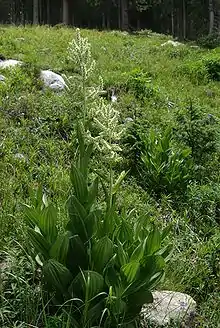Veratrum californicum
Veratrum californicum (California corn lily, white or California false hellebore) is an extremely poisonous plant[1] native to mountain meadows at 3500 to 11,000 ft elevation in southwestern North America, the Sierra Nevada and Rocky Mountains, and as far north as Alaska and as far south as Durango.[2][3] It grows 1 to 2 meters tall, with an erect, unbranched, heavily leafy stem resembling a cornstalk.[4] It prefers quite moist soil, and can cover large areas in dense stands near streams or in wet meadows. Many inch-wide flowers cluster along the often-branched top of the stout stem; they have 6 white tepals, a green center, 6 stamens, and a 3-branched pistil (see image below). The buds are tight green spheres. The heavily veined, bright green leaves can be more than a foot long.[3]
| Veratrum californicum | |
|---|---|
 | |
| Scientific classification | |
| Kingdom: | Plantae |
| Clade: | Tracheophytes |
| Clade: | Angiosperms |
| Clade: | Monocots |
| Order: | Liliales |
| Family: | Melanthiaceae |
| Genus: | Veratrum |
| Species: | V. californicum |
| Binomial name | |
| Veratrum californicum | |
Veratrum californicum displays mast seeding; populations bloom and seed little in most years, but in occasional years bloom and seed heavily in synchrony.[5]
- Varieties[2]
- Veratrum californicum var. californicum – from Washington to Durango
- Veratrum californicum var. caudatum (A.Heller) C.L.Hitchc. – Idaho, Washington, Oregon, N California
Teratogenic effects
It is a source of jervine, muldamine and cyclopamine, teratogens which can cause prolonged gestation associated with birth defects[6] such as holoprosencephaly and cyclopia in animals such as sheep,[1] horses, and other mammals that graze upon it. These substances inhibit the hedgehog signaling pathway.[7]
| Wikimedia Commons has media related to Veratrum californicum. |
Gallery
 Swath of corn lilies in meadow
Swath of corn lilies in meadow Leaves on a young plant
Leaves on a young plant Closeup of flowers
Closeup of flowers
References
- Whitney, Stephen (1985). Western Forests (The Audubon Society Nature Guides). New York: Knopf. p. 551. ISBN 0-394-73127-1.
- Kew World Checklist of Selected Plant Families
- Blackwell, Laird R. (1998). Wildflowers of the Sierra Nevada and the Central Valley. Lone Pine Publishing. ISBN 1-55105-226-1.
- Niehaus, Theodore F.; Ripper, Charles L.; Savage, Virginia (1984). A Field Guide to Southwestern and Texas Wildflowers. Houghton Mifflin Company. pp. 10–11. ISBN 0-395-36640-2.
- Inouye, David W.; Wielgolaski, Frans E. (2003). "High Altitude Climates". In Schwarz, Mark D. (ed.). Phenology: An Integrative Environmental Science. Kluwer Academic Publishers. pp. 195–214. ISBN 1-4020-1580-1. Retrieved 2011-12-07.
- Van Kampen & Ellis. "Prolonged Gestation in Ewes Ingesting Veratrum californicum: Morphological Changes and Steroid Biosynthesis in the Endocrine Organs of Cyclopic Lambs".
- Chen, J; Taipale, J; Cooper, M. (2002). "Inhibition of Hedgehog Signaling by direct binding of Cyclopamine to Smoothened". Genes Dev. 16 (21): 2743–2748. doi:10.1101/gad.1025302. PMC 187469. PMID 12414725.
External links
- Jepson Manual Treatment: var. californicum
- Flora of North America
- Washington Burke Museum
- Photo gallery